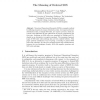6597 search results - page 106 / 1320 » Orderings and Types in Databases |
COLING
2002
13 years 9 months ago
2002
We present a quantitative model of word order and movement constraints that enables a simple and uniform treatment of a seemingly heterogeneous collection of linear order phenomena...
ESOP
2000
Springer
14 years 22 days ago
2000
Springer
Abstract. Type classes in Haskell allow programmers to define functions that can be used on a set of different types, with a potentially different implementation in each case. For ...
MATES
2004
Springer
14 years 2 months ago
2004
Springer
The article presents a general model of the emergence of social order in multi-agent-systems (MAS). The agents consist of two types of neural networks that have the task to generat...
FSTTCS
2006
Springer
14 years 23 days ago
2006
Springer
Structured Operational Semantics (SOS) is a popular method for defining semantics by means of deduction rules. An important feature of deduction rules, or simply SOS rules, are neg...
TCAD
1998
13 years 8 months ago
1998
— Ordered Kronecker functional decision diagrams (OKFDD’s) are a data structure for efficient representation and manipulation of Boolean functions. OKFDD’s are a generalizat...

